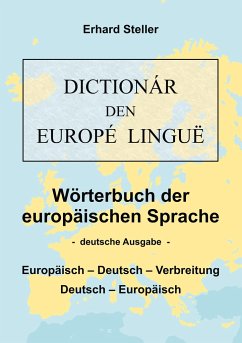Dictionary
The dictionary of the european language
- Orthography
- To the online word list of use-words with spread schemes and numers of speakers. Clicking on "→en" opens a translation of the word meaning to English by glosbe.com.
And This is how the Dictionary Came into Being:
There are european main trends in spelling and pronunciation (phonological-orthographic europeanisms), european main trends in vocabulary and word meanings (lexical europeanisms), as well as european main trends in grammatical forms (morphological europeanisms). Furthermore, there also european main trends concerning syntax and differentiation (formal europeanisms).
Applying now the phonological-orthographic europeanisms to the lexical and morphological europeanisms, taking into account the formal europeanisms, reveals something surprising, which accompanies everyday lives of people from the Atlantic to the Urals: European language.
The advantage of a common lexicography is that, to a certain degree, it informs about all the languages of Europe simultaneously. Only after that one has to specialize in an individual language, which is then much easier. Namely by one to two thirds easier.
The peculiarity of the EuroLSJ procedure is that european language material is collected with the utmost respect for each individual language. The aim of the procedure is to represent ALL languages of Europe as strongly as possible.
In this way, a dictionary of the European language came into being. The aim of the EuroLSJ project is to make this dictionary appear in all European languages.
So far, the dictionary exists only in German. But actually this does not have to irritate you: the content of the dictionary is at 90% language-neutral; The grammar consists mainly of tables that are labeled in international terms. In addition, you will find translations of the usage words into English in the word list above. That means: If you are interested in the dictionary now, also the German edition can already offer you a lot!
The dictionary contains:
- common spelling and national variants (comparative phonetic table, PDF),
- common vocabulary: approx. 2,700 exemplary words of normal and specific language use with approx. 48,000 national variants (sample page, PDF),
- special part: articles and pronouns (sample page, PDF),
- Placenames in common notation so that the national form can be pronounced correctly throughout Europe (sample page, PDF),
- special part: numerals (sample page, PDF),
- common european grammar (sample page, PDF),
Example of a national edition of the dictionary of the european language:

European is a complete language, even though only a small part of it is documented here. For every word and every rule that belongs to a language according to european customs, there is a maximum-european form.
What is described in this dictionary has an average spread of 390 million speakers in Europe, for whom it is part of the mother tongue in 18 national variants.
On the following pages you can look into the book:
ISBN 9-783752-858525 – 468 pages .
translated with the help of Google. last update: 16.03.2020
(c) EuroLSJ 2020
 amazon
amazon